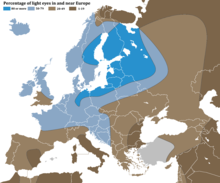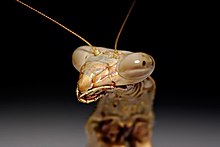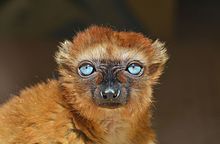Eye colour
Eye color is a visible character caused by two factors: the pigmentation of the eye's iris,[1][2] and way light is scattered as it hits the top layer of the iris.[3]






The human eye is different from its nearest relative, the chimpanzee eye. The eyes of chimps and also gorillas are entirely brown. Humans have the white to their eyes. This difference is thought to be significant. In the apes, individuals do not usually look directly at other members of the family, but all the same they keep a close watch on what is going on with the family group. They tend to look out of the corners of their eyes, as if to keep the glance secret. Perhaps to them a direct look is aggressive. Jane Goodall used to be careful and avoid looking directly at the gorilla families in the bush. She would sit at a distance, appearing to nibble at grass and leaves, while making occasional glances at the gorilla family.
Physical cause
changeIn humans, the pigment of the iris varies from light brown to black. This depends on the amount of melanin in the iris.[4] The appearance of blue, green and hazel eyes result from the Rayleigh scattering of light in the iris. A similar process accounts for the blueness of the sky. Neither blue nor green pigments are ever present in the human iris or fluid.[3][5] Eye color is an example of structural color which varies according to the lighting conditions, especially for lighter-colored eyes.
The brightly colored eyes of many birds, reptiles and insects is caused by other pigments, such as pteridines, purines, and carotenoids.[6]
Genetics
changeThe view that blue eye color is a simple recessive trait is incorrect.[7] Two main gene loci code for the eye pigment: OCA2 and HERC2. They sit next to each other on chromosome 15.[8] Mutations (SNPs) to these genes account for much of the variation seen in eye color. OCA2 mutations close to the 5′ regulatory region explain most human eye-color variation. An intron in HERC2 contains the promoter region for OCA2, affecting its expression. [9]
There are about 15 other genes which have some effect on eye color inheritance. This is an effect called epistasis, and is not unusual.[8]
References
change- ↑ Wielgus A.R. & Sarna T (2005). "Melanin in human irides of different color and age of donors". Pigment Cell Res. 18 (6): 454–64. doi:10.1111/j.1600-0749.2005.00268.x. PMID 16280011.
- ↑ Prota G.; et al. (1998). "Characterization of melanins in human irides and cultured uveal melanocytes from eyes of different colors". Exp. Eye Res. 67 (3): 293–9. doi:10.1006/exer.1998.0518. PMID 9778410.
- ↑ 3.0 3.1 Fox, Denis Llewellyn (1979). Biochromy: natural coloration of living things. University of California Press. p. 9. ISBN 0-520-03699-9.
- ↑ Huiqiong Wang; et al. (2005). "Separating reflections in human iris images for illumination estimation". Tenth IEEE International Conference on Computer Vision (ICCV'05) Volume 1. Vol. 2. pp. 1691–1698. CiteSeerX 10.1.1.87.418. doi:10.1109/ICCV.2005.215. ISBN 0-7695-2334-X. S2CID 2215768.
- ↑ Mason, Clyde W. (1924). "Blue eyes". Journal of Physical Chemistry. 28 (5): 498–501. doi:10.1021/j150239a007.
- ↑ Oliphant LW (1987). "Pteridines and purines as major pigments of the avian iris". Pigment Cell Res. 1 (2): 129–31. doi:10.1111/j.1600-0749.1987.tb00401.x. PMID 3507666.
- ↑ No single gene for eye color, researchers prove. Sciencedaily.com 2007. Retrieved on 2011-12-23.
- ↑ 8.0 8.1 "Genotype–phenotype associations and human eye color", Journal of Human Genetics 2011. White, Désirée; Rabago-Smith, Montserrat (2011). "Genotype-phenotype associations and human eye color". Journal of Human Genetics. 56 (1): 5–7. doi:10.1038/jhg.2010.126. PMID 20944644. S2CID 33808164.
- ↑ Duffy, David L.; et al. (2007). "A three-single-nucleotide polymorphism haplotype in intron 1 of OCA2 explains most human eye-color variation". Am. J. Hum. Genet. 80 (2): 241–52. doi:10.1086/510885. PMC 1785344. PMID 17236130.